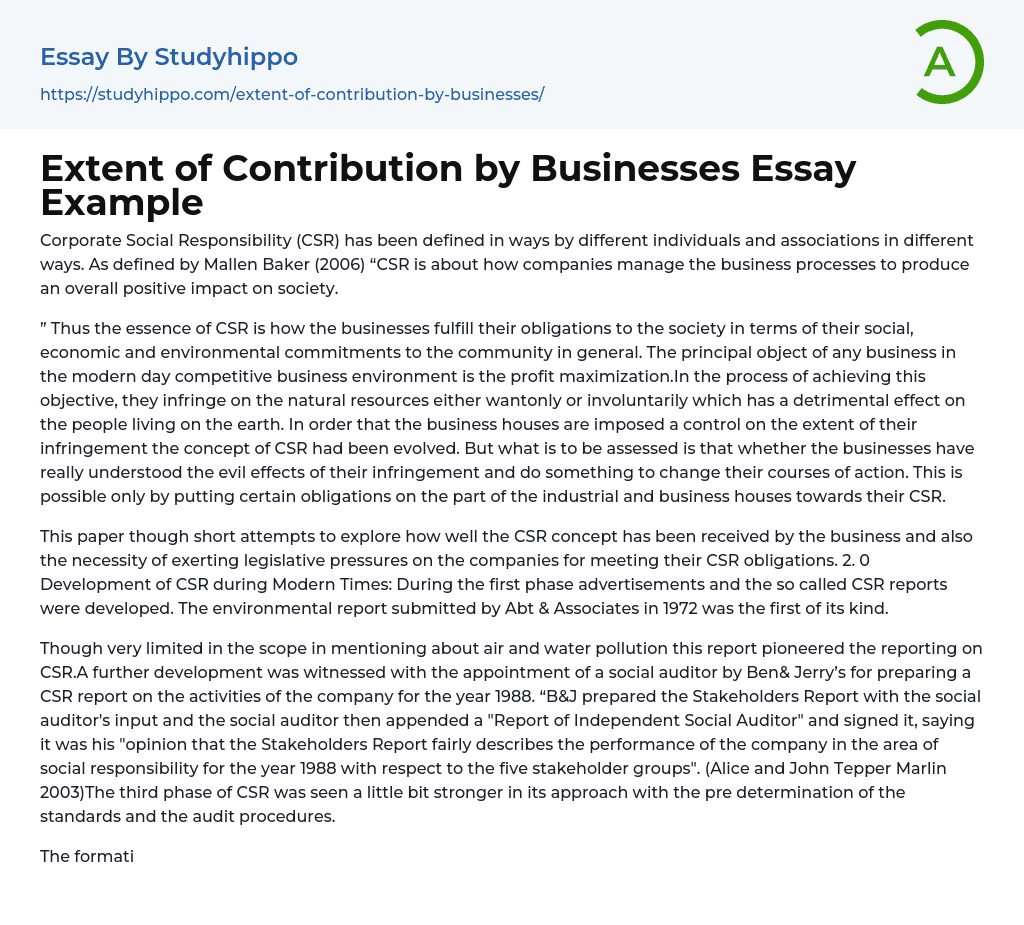There are various interpretations of Corporate Social Responsibility (CSR) by different people and organizations. According to Mallen Baker's definition in 2006, CSR refers to the handling of business operations to create a beneficial societal impact.
The core of CSR involves the manner in which businesses fulfill their societal obligations in relation to their social, economic, and environmental commitments to the general community. In today's competitive business environment, profit maximization is the primary objective of any enterprise, often resulting in the wanton or inadvertent violation of natural resources with damaging consequences for earth's inhabitants. To limit the extent of infringement by businesses, the concept of CSR was developed. However, it is essential to evaluate whether these companies comprehend the negative consequences of their actions and work towards change. This can merely be a
...ccomplished by imposing specific responsibilities on industrial and business organizations concerning their CSR.
This brief exploration delves into the reception of the CSR concept in business and the need for legislative pressure to ensure companies fulfill their CSR duties. The CSR concept developed during modern times, marked by the initial development of CSR reports and advertisements. The first of these reports was the environmental report released by Abt ; Associates in 1972.
Although the report had limited information on air and water pollution, it played a pioneering role in CSR reporting. Ben; Jerry's took an additional step by hiring a social auditor to prepare a CSR report for their activities in 1988. The Stakeholders Report was created with input from the social auditor, who appended an "Independent Social Auditor Report" and signed it, stating that it was his opinion that the report adequatel
described the company's social responsibility performance for that year with regards to the five stakeholder groups (Alice and John Tepper Marlin 2003). The third phase of CSR was more robust in its approach, with predetermined standards and auditing procedures.
The International Social and Environmental Accreditation and Labeling (ISEAL) was a significant merging of standard setting and accreditation bodies. In the fourth phase, legislation like the Sarbenes-Oxley Act 2002 made CSR mandatory with penal provisions for unlawful behavior. The fifth and current phase of CSR development includes the formation of millennium goals and standards for human rights, labor, environment, and anti-corruption. The United Nations established human rights norms and the International Labor Organization set labor standards which greatly facilitated CSR principles.
The implementation of global CSR standards such as Global Compact, ILO Conventions, OECD Guidelines, ISO 14000 standards, SA 8000 standards, AA 1000, World Business Council for Sustainable Development, and Global Reporting Initiative has made fulfilling CSR obligations more detailed and simplified. These standards are supported by various laws and market indices that assist companies in understanding and fulfilling their responsibilities. As a result, definitions have been formulated that accurately outline the expectations for corporate citizens regarding CSR.
- Accounting essays
- Andrew Carnegie essays
- Automation essays
- Business Cycle essays
- Business Intelligence essays
- Business Model essays
- Business Operations essays
- Business Software essays
- Cooperation essays
- Cooperative essays
- Corporate Social Responsibility essays
- Corporation essays
- Customer Relationship Management essays
- Family Business essays
- Franchising essays
- Harvard Business School essays
- Harvard university essays
- Human Resource Management essays
- Infrastructure essays
- Inventory essays
- Logistics essays
- Management essays
- Manufacturing essays
- Market essays
- Marketing essays
- Multinational Corporation essays
- News Media essays
- Online Shopping essays
- Quality Assurance essays
- Richard Branson essays
- Sales essays
- Selling essays
- Shopping Mall essays
- Small Business essays
- Starting a Business essays
- Stock essays
- Strategy essays
- Structure essays
- Trade Union essays
- Waste essays
- Atmosphere essays
- Biodiversity essays
- Coral Reef essays
- Desert essays
- Earth essays
- Ecosystem essays
- Forest essays
- Lake essays
- Natural Environment essays
- Ocean essays




